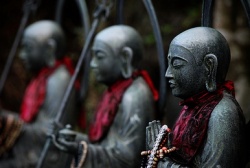Rasa Trulnang Tsuklhagkhang
The Lhasa Tsuklakhang, known also as the Jokhang since the eleventh or twelfth century after its sacred inner sanctum, is Tibet's holiest shrine and the heart of the ancient capital city of Lhasa. Some sources attribute the temple to the Tibetan Emperor Songtsen Gampo while others attribute it to his Nepalese wife Queen Brikuti Devi.
In any case it was the royal couple who was responsible for the building of this temple in the first half of the seventh century. At the time, the Nepalese King Narendradeva and his court lived in exile in Lhasa, known then as Rasa, "the Walled City." The Jokhang was built on the model of an early Indian monastery type known as a vihara, and Newari artisans and craftsmen, likely from Narendradeva's court, worked on the new temple. According to the Fifth Dalai Lama, the Jowo's throne was created by the famed Newar artist Arniko.
Some sources, although from a later historical period, credit Songtsen Gampo's Chinese wife Queen Wencheng with providing the geomantic planning for the Tsuklakhang but this is unlikely as she arrived in Lhasa only in 641 when the Newaris had already departed. The Jokhang houses the Jowo, a statue of the Buddha as a young prince, considered the most sacred religious image in Tibet and brought by Queen Wencheng as part of her dowry.
Over the following two centuries, Songtsen Gampo's successors celebrated the establishment of the Rasa Trulnang Tsuklakhang (the magical apparition of Rasa) as instrumental to the introduction and spread of Buddhism in Tibet. They also made renovations and additions to the Tsuklakhang complex. King Tri Songdetsen cleared the outer courtyard, and King Relpachen had Meru Nyingpa built to the rear of the temple.
Since then, restoration and renovation of the Jokhang became an important activity for the rulers of Tibet. Pakmodrupa Drakpa Gyeltsen built the front extension, also called the Outer Jokhang. The Fifth Dalai Lama and his regents, including Sanggye Gyatso, added further chapels and halls. The Eighth and the Eleventh Dalai Lama and their Tsemonling regents renovated the chapels and the murals. The Thirteenth Dalai Lama repaired the chapels, halls, murals and the roofs.
